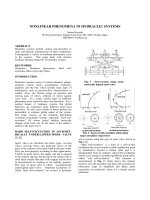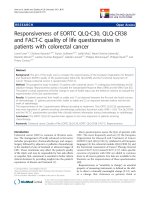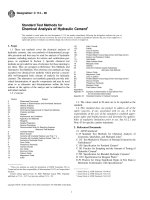Designation: C 563 – 96 - Optimum SO3 in Hydraulic Cement Using 24-h Compressive Strength1 pdf
Bạn đang xem bản rút gọn của tài liệu. Xem và tải ngay bản đầy đủ của tài liệu tại đây (26.18 KB, 3 trang )
Designation: C 563 – 96
Standard Test Method for
Optimum SO
3
in Hydraulic Cement Using 24-h Compressive
Strength
1
This standard is issued under the fixed designation C 563; the number immediately following the designation indicates the year of
original adoption or, in the case of revision, the year of last revision. A number in parentheses indicates the year of last reapproval. A
superscript epsilon (e) indicates an editorial change since the last revision or reapproval.
1. Scope
1.1 This test method describes the determination of opti-
mum SO
3
for maximum 24-h compressive strength by mea-
suring the change in strength produced in hydraulic cement
mortar as a result of substituting calcium sulfate for a portion
of the cement. Usually, but not always, the SO
3
content that
produces the highest 24-h strength at 23°C also produces
approximately the lowest expansion in water and the lowest
contraction in air at that temperature.
1.2 This test method refers to the sulfur trioxide (SO
3
)
content of the cement only. Slag cements and occasionally
other hydraulic cements can contain sulfide or other forms of
sulfur. The determination of SO
3
content by rapid methods may
include these other forms, and may therefore produce a
significant error. If a significant error occurs, analyze the
cement for SO
3
content using the reference test method of Test
Methods C 114 for sulfur trioxide.
1.3 Values stated as SI units are to be regarded as standard.
1.4 This standard does not purport to address all of the
safety concerns, if any, associated with its use. It is the
responsibility of the user of this standard to establish appro-
priate safety and health practices and determine the applica-
bility of regulatory limitations prior to use.
2. Referenced Documents
2.1 ASTM Standards:
C 109/C 109M Test Method for Compressive Strength of
Hydraulic Cement Mortars (Using 2-in. or 50-mm Cube
Specimens)
2
C 114 Test Methods for Chemical Analysis of Hydraulic
Cement
2
C 150 Specification for Portland Cement
2
C 204 Test Method for Fineness of Hydraulic Cement by
Air Permeability Apparatus
2
C 305 Practice for Mechanical Mixing of Hydraulic Cement
Pastes and Mortars of Plastic Consistency
2
C 471 Test Methods for Chemical Analysis of Gypsum and
Gypsum Products
2
C 511 Specification for Moist Cabinets, Moist Rooms and
Water Storage Tanks Used in the Testing of Hydraulic
Cements and Concretes
2
C 595 Specification for Blended Hydraulic Cements
2
C 778 Specification for Standard Sand
2
C 1157 Performance Specification for Blended Hydraulic
Cement
2
3. Significance and Use
3.1 The purpose of this test method is to estimate the SO
3
content for a hydraulic cement that gives maximum 24-h
compressive strength.
3.2 The optimum SO
3
content for 24-h compressive
strength is not necessarily the optimum SO
3
content for later
ages or for volume change. Confirming tests can be made if the
relationships between SO
3
and these properties are not known
for the cement being tested.
3.3 This test method indicates optimum SO
3
content for
cement in mortar made and cured at a standard temperature of
236 1.7°C (73.4 6 3°F). The optimum SO
3
increases with
increasing temperature and may increase when water-reducing
admixtures are used.
3.4 It should not be assumed that the optimum SO
3
esti-
mated in this test method is the same SO
3
content for optimum
performance of a concrete prepared from the cement.
3.5 The test method is applicable to cements specified in
Specifications C 150, C 595, and C 1157.
4. Apparatus
4.1 Use the apparatus as specified in Test Method C 109.
5. Materials
5.1 Calcium Sulfate—Use calcium sulfate for addition to
the cement that is either a high-grade natural gypsum having an
SO
3
content of at least 46 %,
3
or the calcium sulfate from the
source used for the intended plant production. Grind the
calcium sulfate to 100 % passing the 75-µm (No. 200) sieve,
and at least 800 m
2
/kg Blaine fineness (Test Method C 204). If
the SO
3
content of the calcium sulfate is unknown, analyze it
in accordance with Test Methods C 471.
5.2 Blended Standard Sand—Use a blend of equal parts by
1
This test method is under the jurisdiction of ASTM Committee C-1 on Cement
and is the direct responsibility of Subcommittee C01.28 on Sulfate Content.
Current edition approved Dec. 10, 1996. Published February 1997. Originally
published as C 563 – 65. Last previous edition C 563 – 95.
2
Annual Book of ASTM Standards, Vol 04.01.
3
Terra Alba, available from the U.S. Gypsum Co., Southard, OK plant, meets
these requirements for fineness and SO
3
content.
1
Copyright © ASTM, 100 Barr Harbor Drive, West Conshohocken, PA 19428-2959, United States.
mass of graded sand and 20–30 sand, both conforming to
Specification C 778.
6. Test Specimens
6.1 Make six specimens from each batch of mortar. Make
two rounds of three mixtures of mortar as described in 6.3.
Make both rounds during the same day if possible. Make only
complete rounds on any given day.
6.2 Preparing Specimen Molds—Prepare molds in accor-
dance with the section on Preparation of Specimen Molds of
Test Method C 109.
6.3 Proportioning, Consistency, and Mixing of Mortar—
Proportion the dry material for the standard mortar as one part
of cement to one part of blended sand by mass. Mix the
following quantities of dry materials at one time for a 6-cube
batch:
Mixture No. 1—940 g cement
470 g graded sand
470 g 20–30 sand
Mixture No. 2—930 g cement
10 g calcium sulfate
470 g graded sand
470 g 20–30 sand
Mixture No. 3—920 g cement
20 g calcium sulfate
470 g graded sand
470 g 20–30 sand
6.3.1 Use an amount of mixing water that is 30 % by mass
of cement plus calcium sulfate for all types of hydraulic
cement, except for Type III cement where the amount shall be
36 %.
6.3.2 Mix mechanically in accordance with the section on
Procedure for Mixing Mortars of Practice C 305, except as
follows:
6.3.2.1 Add the calcium sulfate to the water; then start the
mixer and mix at slow speed (140 6 5 rpm) for 15 s; then stop
the mixer and add the cement to the water; then start the mixer
and mix at slow speed (140 6 5 rpm) for 30 s.
6.4 Molding of Test Specimens—Mold specimens in accor-
dance with the Procedure Section of Test Method C 109.
6.5 Storage of Test Specimens—Immediately upon comple-
tion of molding, place the test specimens in the moist closet or
moist room. Keep all test specimens, immediately after mold-
ing, in the molds on the base plates in the moist closet or moist
room for 20 to 24 h with their upper surfaces exposed to the
moist air but protected from dripping water. If the specimens
are removed from the molds before 24 h, keep them on the
shelves of the moist closet or moist room until they are 24-h
old.
7. Temperature and Humidity
7.1 The temperature and humidity of the moist cabinet or
moist room shall be as specified in Specification C 511.
7.2 The temperature and humidity of the mixing room shall
be as specified in Test Method C 109.
8. Procedure
8.1 Test the specimens at the age of 24 6
1
⁄
4
h from the time
the cement and water made contact during mixing, immedi-
ately after removal from the moist closet in accordance with
Test Method C 109. If more than one specimen at a time is
removed from the moist closet, keep these specimens covered
with a damp cloth until time of testing. Note and observe
precautions regarding testing and retesting given in the appli-
cable sections of Test Method C 109.
9. Calculation
9.1 Calculate and record the strength of specimens as
described in the section on Calculation in Test Method C 109.
9.1.1 Calculate the indicated optimum SO
3
content as fol-
lows:
G 5
@
a/
~
a 2 b
!
#
c 1 d 1 c/2
where:
G 5 optimum percent SO
3
,
a 5 average strength both rounds of Mixture No. 2 minus
Mixture No. 1,
b 5 average strength both rounds of Mixture No. 3 minus
Mixture No. 2,
c 5 (percent SO
3
in calcium sulfate)/100, and
d 5 percent SO
3
in test cement.
10. Retest
10.1 Regard the results obtained as suspect and repeat the
test under any of the following conditions:
10.1.1 If a and b both are positive and the ratio a/b is less
than 2.00,
10.1.2 If a and b both are negative and the ratio a/b is
greater than 0.500, or
10.1.3 If a is negative and b is positive.
11. Report
11.1 If repeat tests confirm that the ratio of a/b departs from
the limiting values as stated above, report the SO
3
content of
the cement as “above optimum” or “below optimum” as the
data may indicate, but without stating the numerical value of
optimum SO
3
.
11.2 If the test data indicate that the cement is “below
optimum” but do not permit a computation of the percentage of
SO
3
required for optimum, an additional series of tests involv-
ing greater substitutions of gypsum for part of the cement
should yield results that will permit an acceptable calculation
of the percentage of SO
3
required for optimum. If the test data
indicate that the cement is “above optimum” but do not permit
a computation of the percentage of SO
3
required for optimum,
in order to establish the required percentage of SO
3
for
optimum, it is necessary to make tests of a new sample of
similar cement but having an original SO
3
content lower than
that of the original cement.
12. Precision and Bias
12.1 Precision—The coefficient of variation for this test
method, using 6 cubes per batch and testing at 24-h age, is very
similar to that for Test Method C 109 compression cubes tested
at later ages. Refer to Test Method C 109 for suitable values.
12.2 Bias—Since there is no accepted reference material
suitable for determining optimum SO
3
, bias has not been
determined.
13. Keywords
13.1 blended hydraulic cement; calcium sulfate; cement;
C 563
2
compressive strength; gypsum; hydraulic cement; optimum
sulfate content (of cement); portland cement; strength (of
cement); sulfate content (of cement)
The American Society for Testing and Materials takes no position respecting the validity of any patent rights asserted in connection
with any item mentioned in this standard. Users of this standard are expressly advised that determination of the validity of any such
patent rights, and the risk of infringement of such rights, are entirely their own responsibility.
This standard is subject to revision at any time by the responsible technical committee and must be reviewed every five years and
if not revised, either reapproved or withdrawn. Your comments are invited either for revision of this standard or for additional standards
and should be addressed to ASTM Headquarters. Your comments will receive careful consideration at a meeting of the responsible
technical committee, which you may attend. If you feel that your comments have not received a fair hearing you should make your
views known to the ASTM Committee on Standards, 100 Barr Harbor Drive, West Conshohocken, PA 19428.
This standard is copyrighted by ASTM, 100 Barr Harbor Drive, West Conshohocken, PA 19428-2959, United States. Individual
reprints (single or multiple copies) of this standard may be obtained by contacting ASTM at the above address or at 610-832-9585
(phone), 610-832-9555 (fax), or (e-mail); or through the ASTM website ().
C 563
3

![Standard Test Method for Compressive Strength of Hydraulic Cement Mortars (Using 2-in. or [50-mm] Cube Specimens)](https://media.store123doc.com/images/document/14/rc/yi/medium_yil1395845738.jpg)






![Designation: C 109/C 109M – 99 - Compressive Strength of Hydraulic Cement Mortars (Using 2-in. or [50-mm] Cube Specimens)1 pps](https://media.store123doc.com/images/document/2014_07/10/medium_tyk1405009245.jpg)
